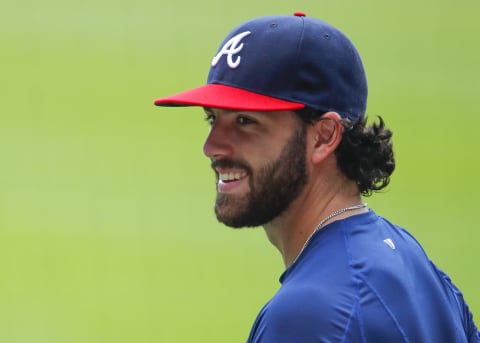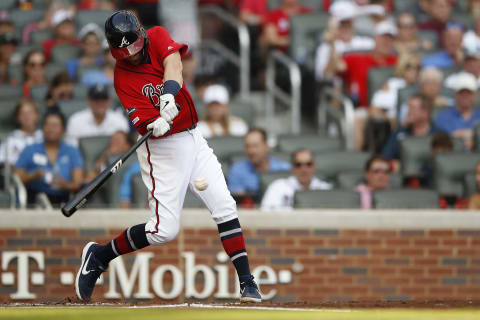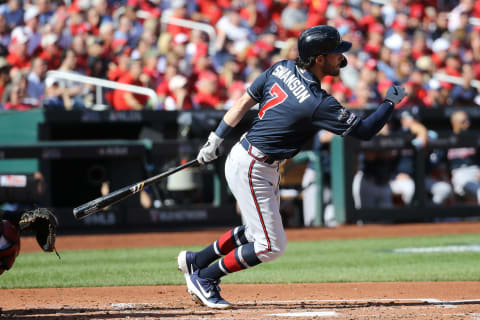Atlanta Braves: Dansby Swanson Primed to Breakout in 2020


Dansby Swanson showed some progress last year, but there are signs he could be on the verge of a breakout.
That would obviously be the best-case scenario for the Atlanta Braves in a shortened 2020 season, to see the former number one overall pick finally bust out as a big-league hitter.
It’s true that Dansby Swanson has been somewhat of a complicated player to measure to this point in his still-young career.
There’s no question that Swanson has solidified his reputation as an above-average fielding shortstop, as well as a great baserunner.
It’s at the plate, however, that the Kennesaw, Ga. native has fallen shy of lofty expectations in his first few seasons as a major leaguer.
Being the first overall pick out of Vanderbilt and drawing comparisons to Derek Jeter (far too early) will, of course, set the bar at a towering height.
It also didn’t help matters that Dansby Swanson’s debut season got off to such a productive start.
In his first 38 games played of his big-league career, all coming late in 2016, Swanson – just 22 years old at the time – hit above .300 with a 107 wRC+, swelling the expectations going into the 2017 campaign.
That hot start did not carry over to his first full season with Atlanta, as Swanson struggled mightily to the tune of a .232 BA and a poor wRC+ of 64.
2018 was also a year of disappointment – offensively – for the Atlanta Braves shortstop, mostly as a result of a lingering wrist injury that clearly impacted Swanson’s swing at the plate.
Thankfully, the injury in 2018 had no real impact on Swanson’s defensive play, which was nothing short of terrific as he totaled 10 defensive runs saved (DRS) for the season and asserted himself as one of the slicker gloves at shortstop in the National League.
Even more, thankfully, the wrist injury was taken care of at the conclusion of the 2018 season, providing Dansby Swanson with the hope of taking steps forward entering 2019.

Something changed for Dansby Swanson as a hitter for the Atlanta Braves in 2019.
On the surface, nothing about Dansby Swanson’s batting totals from last season immediately jump off the page at you.
With the wrist finally healthy, some may have even argued that Swanson’s improvement – with regards to traditional stats – was still underwhelming.
That might be a fair assessment, at first glance.
After all, Swanson finished 2019 with a triple-slash line of .251/.325/.422, which – while admittedly better than the 2017-2018 seasons, where his average slash line was .235/.308/.360 – was still less than stellar.
So what changed? What evidence is there that gives promise that Dansby Swanson is still evolving as a hitter?
The peripherals have something to say.
First, let’s start with the fact that Dansby Swanson hit the ball harder in 2019 than he ever has.
According to Fangraphs, Swanson’s line drive rate last year was 25.8%, a far boost from the 19.9% rate he put up in 2018, and the best he’s done in his career.
MLB.com’s Statcast shows the same trend, for even more context.
Let’s use percentiles (out of all qualified MLB hitters) over the last three years (2017-2019) to see how Dansby Swanson is transforming as a hitter.
- Exit velocity – 34th, 23rd, 66th
- Hard hit rate – 30th, 34th, 67th
- Barrel rate – 15th, 20th, 70th
What’s abundantly clear from those numbers? The third percentile (2019) in each category is vastly higher than the previous two (’17-’18).
Dansby Swanson is squaring up on the ball at a significantly higher rate, and hitting it the hardest he has in his career.
Furthermore, Swanson is elevating the ball more so than year’s past.
Fangraphs also illustrates this point, with Swanson’s 2019 groundball rate being the lowest it has ever been (37.1%) and the home run-to-fly ball ratio the highest it’s ever been (12.6%).
Here’s a fun baseball formula that we all can acknowledge.
Hitting the ball harder + increased elevation in contact typically equals…you guessed it, more home runs.
This was also true for Dansby Swanson in 2019, with his 17 long balls surpassing his previous career-best of 14, and his isolated power (ISO) at a career-best .172.
Make no mistake about it, Dansby Swanson is still developing as a hitter.
In a day and age in which many hitters are adjusting their swings to find increased exit velocity and more optimal launch angles, Swanson is starting to see those results in the form of much higher ranks within the MLB percentiles.
What does it mean for the future?

Dansby Swanson projects to have an improved 2020 season at the plate for the Atlanta Braves.
So now we’ve arrived at the bizarre season that 2020 will have to offer.
What can Dansby Swanson do for the Atlanta Braves in a sprint to the postseason?
Obviously, with only 60 regular-season games on the slate, let’s put less of an emphasis on counting stats and focus more on rates.
Given the aforementioned adjustments that Dansby Swanson has made to his swing, which has made for better contact and more extra-base hits, I’ll go ahead and say that I project for those trends to continue in 2020.
Not to mention that he’s fresh off a strong performance in last year’s NLDS vs the St. Louis Cardinals (7-of-18 with 3 doubles and 2 very clutch RBI).
I’m going bullish on Dansby here.
With a short season in mind, I believe he’ll surpass the .280 threshold for his batting average, and that his on-base percentage will also eclipse the .350 mark.
Just for fun, I think his ISO will also continue to increase – up to .180 from last year’s .172 – and that in 57 to 58-ish regular season games played, Dansby will club 8 homers, while driving in between 27-30.
Sure, I’m more optimistic than most might be.
Call me a believer in the peripherals of 2019 – Dansby Swanson is morphing at the plate, and I think he’ll show that again in this abbreviated 2020 campaign.
Next. Can Riley Rebound in 2020. dark
That, of course, would be great news for the Atlanta Braves in their quest for another NL East division title.